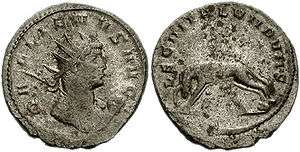Legio II Italica

Legio secunda Italica ("Italian Second Legion"), was a legion of the Imperial Roman army.
Formation
The legion was founded in AD 165 by emperor Marcus Aurelius (r. 161-80) alongside III Italica at a time when the Roman Empire was fighting both in Germania and in Parthia.
Unit history
The legion main theatre of operations was the Roman province of Noricum, in the south margin of the Danube, where Germanic incursions were frequent.
In 180 II Italica was stationed in Lauriacum, modern Lorch.
Year of the five Emperors
In 193, II Italica marched into Rome with Septimius Severus, then fighting for power. The new emperor awarded them the title of Fidelis (loyal) to acknowledge the support. Later Septimius Severus would use II Italica against the rebellions of Pescennius Niger and Clodius Albinus, and in his Parthian campaigns.
Under Gallienus
In the 3rd century, support of the legions was a crucial demand for candidates to the throne. Well aware of this fact, Gallienus granted II Italica the cognomina VII Pia VII Fidelis (seven times faithful, seven times loyal) to secure their continuing support.
Later service
There are still records of the II Italica in Noricum in the beginning of the 5th century.
Symbol
The legion symbol is a she-wolf and the twins Romulus and Remus, and is a reference to the rule of Marcus Aurelius and his colleague Lucius Verus.
See also
External links
